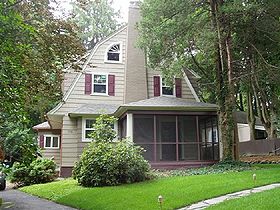- Dutch Colonial Revival architecture
-
 Example of Dutch Colonial Revival, Plainfield, New Jersey.
Example of Dutch Colonial Revival, Plainfield, New Jersey.
Dutch Colonial is a style of domestic architecture, primarily characterized by gambrel roofs having curved eaves along the length of the house. Modern versions built in the early 20th century are more accurately referred to as "Dutch Colonial Revival," a subtype of the Colonial Revival style.
Contents
History
The modern use of the term is to indicate a broad gambrel roof with flaring eaves that extend over the long sides, resembling a barn in construction. The early houses built by settlers were often a single room, with additions added to either end (or short side) and very often a porch along both long sides. Typically, walls were made of stone and a chimney was located on one or both ends. Common were double-hung sash windows with outward swinging wood shutters and a central double Dutch door.
- Settlers of the Dutch colonies in New York, Delaware, New Jersey, and western Connecticut built these homes in ways familiar to the regions of Europe from which they came, like the Low Countries, the Palatine parts of Germany, and Huguenot regions of France. Used for its modern meaning of "gambrel-roofed house", the term does not reflect the fact that housing styles in Dutch-founded communities in New York evolved over time. In the Hudson Valley, for example, the use of brick, or brick and stone is perhaps more characteristic of Dutch Colonial houses than is their use of a gambrel roof. In Albany and Ulster Counties, frame houses were almost unknown before 1776, while in Dutchess and Westchester Counties, the presence of a greater proportion of settlers with English roots popularised more construction of wood-frame houses[1]. After a period of log cabin and bank-dugout construction, the use of the inverted "V" roof shape was common. The gambrel roof was used later, predominantly between 1725 and 1775, although examples can be found from as early as 1705[2]. The general rule before 1776 was to build houses that were only one-and-a-half stories high, except in Albany, where there were a greater proportion of two-story houses. Fine examples of these houses can be found today, like those in the Huguenot Street Historic District of New Paltz, New York.
- However, at least one other source[citation needed] states that this style of home originated with German, or “Deutsch” settlers in Pennsylvania.
Revival in the 20th Century
Early 20th century Dutch Revival buildings on S William Street in lower Manhattan recall the Dutch origins of the city. The original 17th century architecture of New Amsterdam has completely vanished (affected by the fires of 1776 and 1835),[3][4] leaving only archaeological remnants.
Beginning in the late 19th century, America began to look back romantically upon its colonial roots and the country started reflecting this nostalgia in its architecture. Within this Colonial Revival, one of the more popular designs was a redux of features of the original Dutch Colonial.
Within the context of architectural history, the more modern style is specifically defined as "Dutch Colonial Revival" to distinguish it from the original Dutch Colonial. However, this style was popularly known simply as Dutch Colonial, and this continues to be the case today.
Up and through the 1930s, Dutch Colonials were most popular in the Northeast. While the original design was always reflected, some details were updated such as the primary entryway moving from the end to the long side of the house. The more modern versions also varied a great deal with regard to materials used, architectural details, and size. For example one Dutch Colonial might be a small two-story structure of 1,400 square feet (130 m2) with dormers bearing shed-like overhangs, while another larger example would have three stories and a grand entrance adorned with a transom and sidelights.
Famous Dutch Colonial houses
One of the most famous houses in this style is 112 Ocean Avenue, which became infamous as the site of the Amityville Horror.
See also
References
- ^ Helen Wilkinson Reynolds, Dutch Houses in the Hudson Valley Before 1776, Payson and Clarke Ltd. for the Holland Society of New York, 1929. Reprinted by Dover Publications Inc. 1965. p. 22
- ^ Ibid., p. 23
- ^ NY Public Library Picture Collection. "Map of Great Fire 1776". http://www.bklyn-genealogy-info.com/Map/1776greatfire.html. Retrieved 2008-01-17.
- ^ CUNY. "Map of Damages - 1835". http://www.virtualny.cuny.edu/Search/search_res_image.php?id=502. Retrieved 2008-01-17.
External links
- Colonial Homes with Gambrel Roofs by Sarah E. Mitchell (including link to article regarding Dutch Colonial Revival)
- Dictionary.com Definition of Dutch Colonial
- Realtor.org Overview of Dutch Colonial style (includes perhaps erroneous reference to German origin of style)
Categories:- Dutch Colonial Revival architecture
- Revival architectural styles
- Colonial architecture in the United States
- American architectural styles
- Dutch architectural styles
Wikimedia Foundation. 2010.

